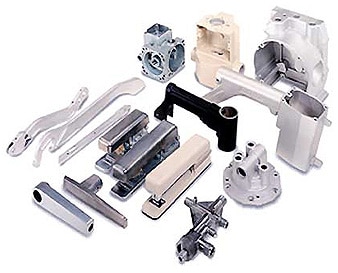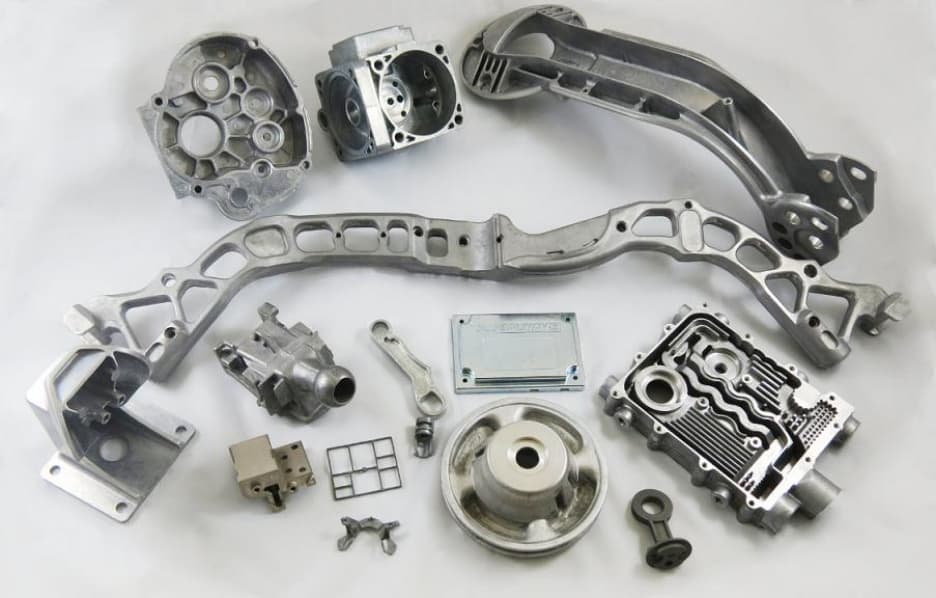Why Wisconsin Aluminum Foundry is trusted across various sectors
Wiki Article
Discovering the Conveniences and Practical Use Light Weight Aluminum Castings in Today's Market
Light weight aluminum spreadings have actually come to be progressively appropriate in different sectors as a result of their distinct qualities. Their light-weight nature and resistance to deterioration make them appropriate for requiring applications. In addition, the superior strength-to-weight ratio uses considerable benefits in layout and production. As industries proceed to discover their possibility, the full range of light weight aluminum spreadings' applications and benefits continues to be to be fully revealed. What lies in advance for this functional material?The Lightweight Benefit of Light Weight Aluminum Castings
Although many materials are made use of in production, light weight aluminum castings stick out mainly due to their lightweight homes. This characteristic makes light weight aluminum spreadings an eye-catching selection for numerous industries, specifically in aerospace and vehicle applications, where weight reduction is crucial for boosting gas performance and efficiency. The lightweight nature of aluminum allows suppliers to produce components that are less complicated to mount and deal with, eventually decreasing labor costs.The capacity to produce complicated shapes without significant weight penalties enables developers to innovate while keeping architectural stability. Aluminum spreadings can properly change heavier materials, bring about significant cost savings in shipping and operational prices. Their light-weight advantage also contributes to enhanced product durability, as lighter parts typically lead to reduced damage on equipment. Overall, the light-weight homes of aluminum castings give manufacturers with a competitive edge, fostering advancements in item style and effectiveness throughout different sectors.

Outstanding Deterioration Resistance
Light weight aluminum castings have a natural resistance to oxidation, which considerably boosts their durability in different atmospheres. This integral property not just adds to their resilience however additionally lines up with the lightweight advantage that light weight aluminum uses. Therefore, light weight aluminum castings are increasingly recognized for their extraordinary corrosion resistance in countless applications.
Naturally Immune to Oxidation
Among the standout attributes of light weight aluminum spreadings is their outstanding corrosion resistance, which stems from a natural oxidation process. When subjected to air, light weight aluminum reacts to create a slim, safety layer of aluminum oxide. This layer serves as an obstacle against additional oxidation and secures the underlying metal from harsh components such as moisture and salts. Unlike other steels, this oxide layer is self-repairing; if damaged, it quickly reforms when subjected to air. This special residential or commercial property boosts the longevity of aluminum castings in numerous environments, making them excellent for applications in industries such as aerospace, automobile, and marine. Consequently, the natural resistance to oxidation greatly reduces maintenance expenses and boosts the dependability of aluminum castings in demanding problems.Lightweight Durability Benefit
The lightweight nature of light weight aluminum spreadings adds significantly to their durability, making them a helpful choice in various industries. This phenomenal toughness is mostly credited to light weight aluminum's natural resistance to deterioration, which is boosted better with anodizing and other surface area therapies. Unlike numerous metals, aluminum does not corrosion; instead, it creates a protective oxide layer that guards it from environmental damage. This residential or commercial property is specifically beneficial in fields such as automobile and aerospace, where weight decrease is vital without endangering strength. Furthermore, the durability of light weight aluminum castings minimizes upkeep prices and replacements, giving economic advantages with time. Their lightweight durability and deterioration resistance setting aluminum castings as a superior product for modern-day production applications.
Superior Strength-to-Weight Proportion
An impressive attribute of light weight aluminum castings is their exceptional strength-to-weight proportion, which makes them highly desirable in different applications. This innate residential property enables aluminum castings to hold up against significant anxiety while remaining lightweight, an essential consider markets such as aerospace, vehicle, and production. Engineers typically choose aluminum castings for elements that need both resilience and decreased weight, boosting fuel performance and performance.The high strength-to-weight ratio likewise assists in the layout of detailed shapes and structures, making light weight aluminum castings versatile for complicated applications. The capability to keep architectural integrity under difficult problems warranties durability and integrity in items, from aircraft frameworks to automotive parts. This benefit adds to the growing fad of utilizing aluminum spreadings in ingenious styles, eventually resulting in enhanced performance and efficiency throughout varied sectors. As a result, the premium strength-to-weight ratio of light weight aluminum castings places them as a pivotal product in modern-day design and production.
Cost-Effectiveness in Manufacturing
Cost-effectiveness in aluminum spreading manufacturing is mostly achieved with decreased product waste and reliable production procedures. By enhancing layouts and making use of sophisticated techniques, producers can reduce excess material usage while keeping quality requirements. This strategy not only reduces manufacturing costs yet likewise adds to more sustainable methods within the sector.Decreased Product Waste
Decreasing material waste in light weight aluminum casting processes considerably boosts manufacturing performance. By enhancing the design and manufacturing methods, business can minimize excess scrap and boost source utilization. This reduction in waste not only lowers product prices yet additionally adds to an extra lasting manufacturing version. The capacity to recycle aluminum further assistances cost-effectiveness, allowing suppliers to recover and recycle products without compromising high quality. As the industry significantly concentrates on sustainability, minimized material waste straightens with ecological objectives while at the same time improving profitability. Eventually, efficient use of resources strengthens the competitive position of organizations on the market, making aluminum castings a favorable option in various applications. The calculated strategy to lessening waste mirrors a dedication to both eco-friendly and financial duty.Efficient Manufacturing Processes
While conventional manufacturing processes can sustain significant costs, light weight aluminum casting supplies an extra efficient option that improves overall production productivity. This method lessens material waste and permits for specific control over the manufacturing process, leading to decreased labor and functional go to the website expenses. The ability to generate intricate forms with fewer steps further enhances production, adding to shorter preparations. In addition, light weight aluminum's lightweight nature and excellent thermal conductivity enable energy savings throughout manufacturing and in the last application. By using contemporary casting innovations, producers can attain higher throughput without sacrificing high quality. Consequently, aluminum spreading sticks out as a cost-efficient service, making it an eye-catching alternative for services aiming to enhance their manufacturing processes in today's open market.Versatility Throughout Industries
Aluminum spreadings show exceptional versatility throughout various industries, as they can be tailored to meet certain demands and applications. In the automotive sector, light weight aluminum castings are made use of in engine blocks, transmission real estates, and wheels, using lightweight yet long lasting remedies that improve gas effectiveness. The aerospace sector additionally takes advantage of light weight aluminum castings, utilizing them in architectural parts and engine components because of their strength-to-weight proportion.In the durable goods sector, manufacturers use light weight aluminum castings for products varying from pots and pans to furniture, giving both visual charm and capability. The electronic devices sector makes use of aluminum castings for real estates and warm sinks, guaranteeing efficient thermal management. Furthermore, the building field leverages aluminum castings for architectural components and building aspects, boosting durability and design adaptability. This wide applicability highlights aluminum spreadings as a necessary source, meeting the varied needs of numerous markets while maintaining high performance and dependability.
Sustainability and Ecological Influence
As industries increasingly prioritize lasting methods, aluminum castings become an eco-friendly choice because of their recyclability and low ecological impact. Aluminum is just one of one of the most recycled materials worldwide, with the ability to be repurposed several times without deterioration of high quality. This particular substantially lowers the need for resources and energy consumption related to main light weight aluminum production, which is energy-intensive.Furthermore, light weight aluminum spreadings add to light-weight styles, resulting in sustain effectiveness in transport applications such as aerospace and automotive markets. Their longevity and resistance to rust expand product life-spans, even more minimizing waste and source use gradually. Lots of manufacturers are adopting responsible sourcing and ecologically pleasant manufacturing approaches, boosting the sustainability of aluminum spreading processes. Overall, light weight aluminum spreadings represent a sensible solution for services intending to minimize their environmental impact while accomplishing efficiency and efficiency.
Technologies in Light Weight Aluminum Spreading Technologies
Current improvements in light weight aluminum casting technologies have actually considerably boosted the performance and quality of manufacturing procedures. Developments such as 3D printing and progressed mold-making techniques have made it possible for producers to develop elaborate designs with lowered product waste. This shift not only boosts the accuracy of actors elements but likewise reduces preparations, enabling fast prototyping and faster market entrance.
The unification of advanced computer system simulations aids in anticipating prospective problems during casting, leading to higher-quality results. Using lightweight alloys has actually likewise added to the development of stronger, more resilient products, providing to industries ranging from automotive to aerospace
Furthermore, automated casting procedures have actually arised, reducing human error and increasing manufacturing rate. Collectively, these technologies are changing the aluminum casting landscape, driving greater competition and find sustainability in manufacturing. As industries proceed to develop, these technologies will certainly play an important function in meeting future needs for performance and quality.
Often Asked Questions
How Do Light Weight Aluminum Castings Compare to Various Other Metals in Regards To Thermal Conductivity?
Aluminum castings show remarkable thermal conductivity contrasted to lots of metals, such as steel and iron - Aluminum Foundry. Their lightweight nature and effective warm circulation make them perfect for applications needing reliable thermal administration in different marketsWhat Are the Typical Flaws Found in Light Weight Aluminum Castings?
Common problems in aluminum spreadings consist of porosity, shrinkage, additions, and surface abnormalities. These issues typically occur from improper click to read more air conditioning rates, poor mold and mildew design, or contaminations, impacting the total top quality and performance of the end product.Can Aluminum Castings Be Recycled, and Just how?
Aluminum spreadings can be reused successfully. The process includes gathering, melting, and changing the light weight aluminum, which reduces waste and conserves resources. This reusing adds to sustainability while preserving the product's buildings for future usage.What Are the Normal Lead Times for Light Weight Aluminum Casting Production?
Generally, lead times for aluminum casting manufacturing variety from two to six weeks, depending upon aspects such as intricacy, tooling requirements, and production volume. Effectiveness can boost with well-known supplier connections and enhanced manufacturing procedures.Just how Does the Surface Finish Affect Aluminum Spreading Efficiency?
The surface area coating considerably influences light weight aluminum spreading performance by influencing deterioration resistance, aesthetic high quality, and rubbing features. A smoother finish enhances durability and performance, while a rougher appearance can boost bond for subsequent coatings or treatments.Several products are used in manufacturing, aluminum spreadings stand out primarily due to their light-weight homes. When revealed to air, aluminum reacts to form a slim, safety layer of light weight aluminum oxide. Cost-effectiveness in aluminum casting manufacturing is mainly attained via minimized material waste and reliable production procedures. Minimizing material waste in light weight aluminum spreading procedures significantly boosts production effectiveness. Ultimately, efficient usage of raw products reinforces the affordable placement of companies in the market, making aluminum castings a positive alternative in various applications.
Report this wiki page